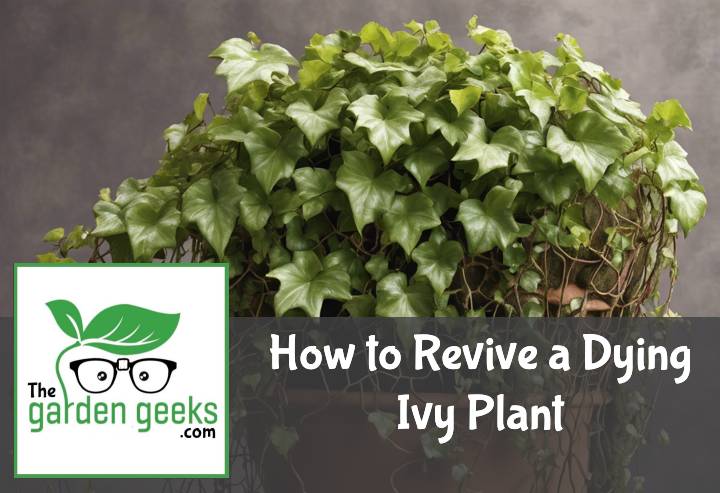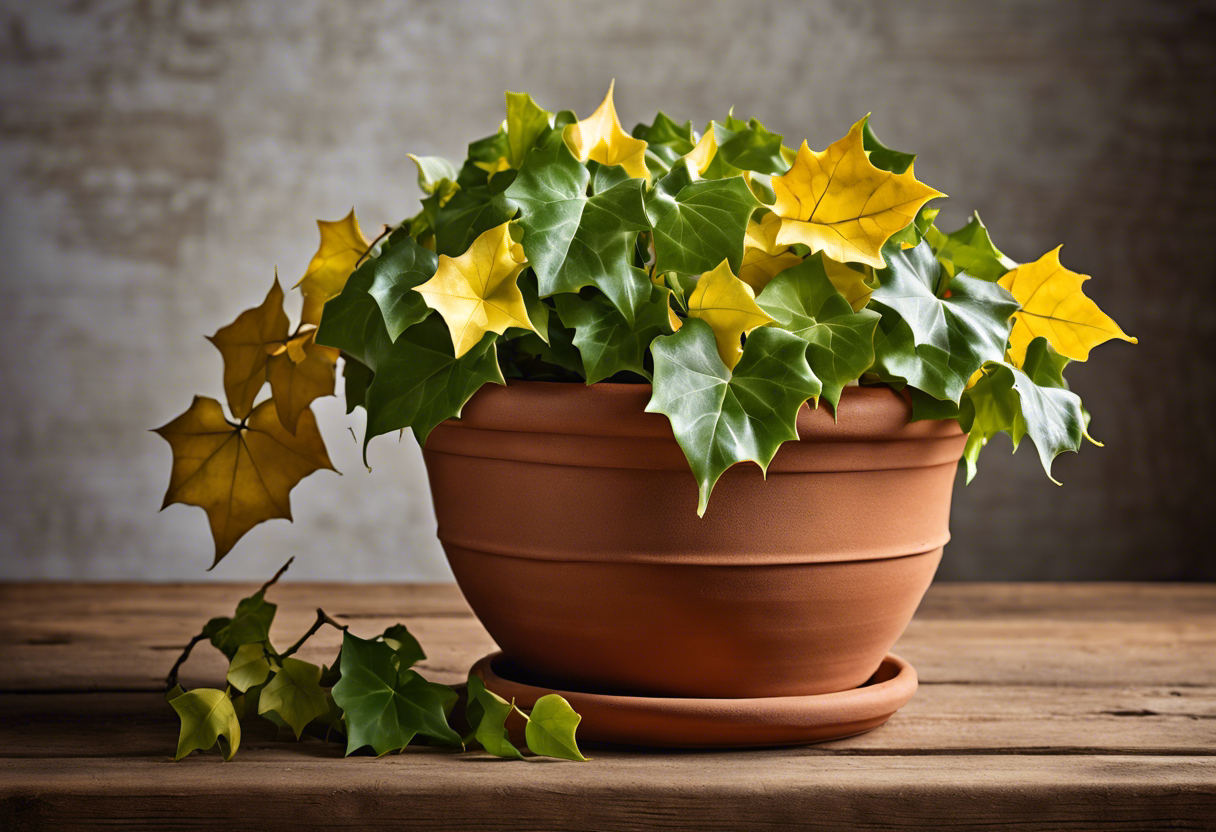Ever found yourself in a green thumb crisis, staring at your once-thriving Ivy plant now looking more like a prop from a horror movie? Well, you’re not alone. I’ve been there too, and let me tell ya, it’s not the end of the world. Learning How to Revive a Dying Ivy Plant can be as thrilling as watching your favorite superhero save the day!
Don’t lose hope just yet! Remember that time when you burned dinner but then turned it into an impromptu pizza night? This is kind of like that. Keep reading about ‘How to Revive a Dying Ivy Plant’. We’re about to turn this botanical blunder into a triumphant tale of plant revival!
Key Takeaways
- Identify the problem with your dying ivy plant, which could be due to overwatering, underwatering, or pest infestation.
- Adjust watering habits based on the plant’s needs; ivy plants prefer moist but not soggy soil.
- Provide adequate light; ivy plants thrive in bright, indirect sunlight.
- Use a balanced fertilizer to provide necessary nutrients.
- If pests are present, use an insecticidal soap or neem oil.
- Prune dead leaves and stems to promote new growth.
Understanding the Problem
Hey there, green thumb! So, your ivy’s looking a bit under the weather? No worries. We’ve got you covered. First things first, understanding ivy plant problems is crucial in figuring out how to revive a dying ivy plant.
Identifying Signs of a Dying Ivy Plant
Now, let’s get down to business. Recognizing an unhealthy ivy isn’t rocket science. You just need to know what to look for. If your ivy leaves are wilting or turning yellow, it’s time to spring into action.
But wait, there’s more! Are the leaves dropping like flies? That’s another tell-tale sign of an unhealthy ivy. Remember, identifying dying plants early can save them from further deterioration.
Common Causes of Ivy Plant Deterioration
Alright, so we’ve identified the signs of a struggling ivy. Now let’s talk about why this happens. Often times, it boils down to improper care – too much love can be harmful too!
Overwatering is a common culprit behind dying ivies. Yes, they need water but not a flood! Similarly, insufficient light can also lead to deterioration – these guys love their sunbaths!
And let’s not forget soil conditions! Poor soil conditions can wreak havoc on your beloved ivies. So remember folks – right amount of water + ample sunlight + good soil = Happy Ivy!
Assessing Your Ivy Plant’s Health
When it comes to How to Revive a Dying Ivy Plant, the first step is understanding your plant’s health. This includes checking the soil condition, evaluating light and temperature conditions, and inspecting for any pesky pests or diseases.
Checking the Soil Condition
The soil is like the ivy’s lunchbox. If it ain’t good, your plant won’t be happy! Start by assessing the soil condition. Healthy ivy soil should be well-draining and rich in organic matter.
Next, check out those moisture levels. Ivies love moist (but not soggy) soil, so make sure you’re not overwatering or underwatering.
Lastly, don’t forget about pH balance! Ivies prefer slightly acidic to neutral pH levels. So if your plant looks unhappy, it might be time for a soil test.
Evaluating Light and Temperature Conditions
Now let’s talk about light and temperature – two key factors in your ivy’s comfort zone. First up, ivy light requirements. These plants are fans of bright but indirect light – too much direct sunlight can scorch their leaves.
As for temperature, think room temperature – that’s what an ivy likes best! The optimal temperature for ivy plants is between 60-80°F (15-27°C).
And remember, if you’re growing your ivy indoors, ensure it gets enough indoor lighting.
Inspecting for Pests or Diseases
Last but definitely not least, keep an eye out for uninvited guests on your plant. Yep, we’re talking about pests and diseases! When inspecting for pests on ivies look out for common culprits like aphids or spider mites.
Common diseases in ivy plants include leaf spot and root rot – so watch out for yellow leaves or a wilting plant.
Remember, an ounce of prevention is worth a pound of cure! Regularly checking your ivy’s health can save you a lot of trouble down the line.
Reviving Techniques for a Dying Ivy Plant
Ah, the trials and tribulations of Ivy plant care. It’s not all doom and gloom, though! With a little bit of knowledge and some elbow grease, you can turn your wilting wallflower into a thriving vine. The key to reviving dying plants, especially an indoor ivy plant revival, lies in adjusting watering practices, modifying light and temperature exposure, and repotting the plant.
Adjusting Watering Practices
Now let’s talk about water – it’s like the coffee for your ivy. Too much or too little can lead to an unhappy plant. Overwatering is like giving your ivy a caffeine overdose – it can cause root rot. On the other hand, underwatering is akin to depriving it of its morning cuppa joe – it can lead to wilted leaves.
So what’s the Goldilocks zone for ivy plant watering? Well, you want the soil to be moist but not soggy. Think damp sponge rather than soaked towel. And remember folks, when it comes to watering your ivy, consistency is key!
Modifying Light and Temperature Exposure
Next up on our agenda is light and temperature. Your ivy isn’t a sun worshipper – too much light can scorch its leaves. But don’t stick it in a dark corner either; these plants need bright but indirect light.
Temperature-wise, think room temp beer rather than ice-cold lager or piping hot tea. Ivies prefer temperatures between 60-80°F (15-27°C). So avoid placing them near radiators or air conditioners.
Remember folks, getting the right balance of light and temperature is crucial for modifying light exposure for ivies and adjusting temperature for healthy ivies.
Repotting the Ivy Plant
Last but not least, let’s talk about repotting. If your ivy is looking a bit peaky and its growth has slowed down, it might be time for a change of scenery.
Repotting an ivy plant can give it the room it needs to spread its roots and flourish. Look out for signs like yellowing leaves or stunted growth – these could be signs your ivy needs repotting.
When you’re ready to take the plunge, make sure you choose a pot that’s one size bigger than the current one and use fresh potting soil. And remember, folks, when it comes to how to revive a dying Ivy plant, sometimes all it takes is a little TLC!
Treating Pests and Diseases in Ivy Plants
When it comes to how to revive a dying ivy plant, one can’t ignore the role of pests and diseases. They’re like that uninvited guest who crashes your party, causing all sorts of havoc. So, let’s dive into the world of ivy plant care and learn about pest control and disease treatment.
Identifying Common Pests and Diseases
First things first, you gotta know your enemy! In the case of ivy plants, common culprits include pests like spider mites, aphids, or scale insects. These tiny troublemakers are often found on the underside of leaves or along stems.
Now onto diseases – black spot fungus and bacterial leaf spot are two common ones that can plague your beloved ivy. Symptoms? Look for yellowing leaves with dark spots or a general decline in plant health. Remember folks, knowledge is power when it comes to pest identification and spotting disease symptoms!
Safe and Effective Treatment Methods
Alright, now that we’ve identified our foes, let’s talk about how to kick them out! For pests, insecticidal soaps or neem oil sprays work wonders. Just remember to test a small area first to avoid any adverse reactions.
For diseases like fungal or bacterial infections, try removing affected leaves and improving air circulation around your plant. And don’t forget about preventive measures! Regularly cleaning your plant’s leaves can do wonders for preventing issues before they start.
Remember folks, effective pest treatment methods and proactive preventive plant care are key in maintaining your ivy’s health. After all, an ounce of prevention is worth a pound of cure in indoor gardening!
Preventive Measures to Keep Your Ivy Healthy
Hey there, green thumbs! Let’s talk about maintaining ivy health. You see, prevention is better than cure, even in the world of plants. It’s all about regular ivy plant care and spotting potential issues before they turn your leafy friend into a wilting wallflower.
Regular Care Routine for an Ivy Plant
So what does a regular care routine look like? Well, it starts with watering. Yes, your ivy needs a drink but not too much! Overwatering can lead to root rot. So keep the soil moist but not soggy.
Next up is sunlight. Your ivy loves a bit of sunbathing but doesn’t want to get burnt! A spot with bright indirect light works best.
Feeding time now! Use a balanced houseplant fertilizer every month during spring and summer. This will help promote healthy ivy growth.
Lastly, don’t forget pruning. Regularly snipping off dead leaves helps your plant stay healthy and bushy.
Monitoring for Early Signs of Trouble
Now let’s move on to the detective work – looking out for early signs of trouble. This is crucial in prevention in plant care because it allows you to act fast and potentially save your plant from serious damage.
Keep an eye out for yellow leaves or brown spots – these could be signs of overwatering or disease. Also, watch for pests like spider mites that love feasting on ivy plants.
Remember, knowing how to revive a dying Ivy Plant starts with preventing it from getting sick in the first place! So stay vigilant and give your ivy the TLC it deserves.
To Wrap Up
So, there you have it folks. Reviving your dying ivy plant is like rekindling a dwindling flame; it requires patience, the right tools, and a little bit of love. Remember to check for signs of distress, adjust watering habits and ensure proper lighting.
Don’t let your green thumb turn blue! Check out How to Revive a Dying Ivy Plant for more juicy details. Keep those leaves lush and vibrant. After all, every plant deserves a second chance at life!





